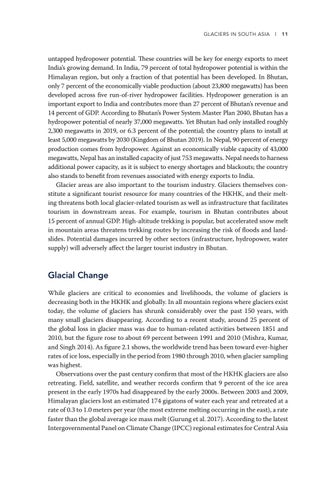Glaciers in South Asia l 11
untapped hydropower potential. These countries will be key for energy exports to meet India’s growing demand. In India, 79 percent of total hydropower potential is within the Himalayan region, but only a fraction of that potential has been developed. In Bhutan, only 7 percent of the economically viable production (about 23,800 megawatts) has been developed across five run-of-river hydropower facilities. Hydropower generation is an important export to India and contributes more than 27 percent of Bhutan’s revenue and 14 percent of GDP. According to Bhutan’s Power System Master Plan 2040, Bhutan has a hydropower potential of nearly 37,000 megawatts. Yet Bhutan had only installed roughly 2,300 megawatts in 2019, or 6.3 percent of the potential; the country plans to install at least 5,000 megawatts by 2030 (Kingdom of Bhutan 2019). In Nepal, 90 percent of energy production comes from hydropower. Against an economically viable capacity of 43,000 megawatts, Nepal has an installed capacity of just 753 megawatts. Nepal needs to harness additional power capacity, as it is subject to energy shortages and blackouts; the country also stands to benefit from revenues associated with energy exports to India. Glacier areas are also important to the tourism industry. Glaciers themselves constitute a significant tourist resource for many countries of the HKHK, and their melting threatens both local glacier-related tourism as well as infrastructure that facilitates tourism in downstream areas. For example, tourism in Bhutan contributes about 15 percent of annual GDP. High-altitude trekking is popular, but accelerated snow melt in mountain areas threatens trekking routes by increasing the risk of floods and landslides. Potential damages incurred by other sectors (infrastructure, hydropower, water supply) will adversely affect the larger tourist industry in Bhutan.
Glacial Change While glaciers are critical to economies and livelihoods, the volume of glaciers is decreasing both in the HKHK and globally. In all mountain regions where glaciers exist today, the volume of glaciers has shrunk considerably over the past 150 years, with many small glaciers disappearing. According to a recent study, around 25 percent of the global loss in glacier mass was due to human-related activities between 1851 and 2010, but the figure rose to about 69 percent between 1991 and 2010 (Mishra, Kumar, gure 2.1 shows, the worldwide trend has been toward ever-higher and Singh 2014). As fi rates of ice loss, especially in the period from 1980 through 2010, when glacier sampling was highest. Observations over the past century confirm that most of the HKHK glaciers are also retreating. Field, satellite, and weather records confirm that 9 percent of the ice area present in the early 1970s had disappeared by the early 2000s. Between 2003 and 2009, Himalayan glaciers lost an estimated 174 gigatons of water each year and retreated at a rate of 0.3 to 1.0 meters per year (the most extreme melting occurring in the east), a rate faster than the global average ice mass melt (Gurung et al. 2017). According to the latest Intergovernmental Panel on Climate Change (IPCC) regional estimates for Central Asia




